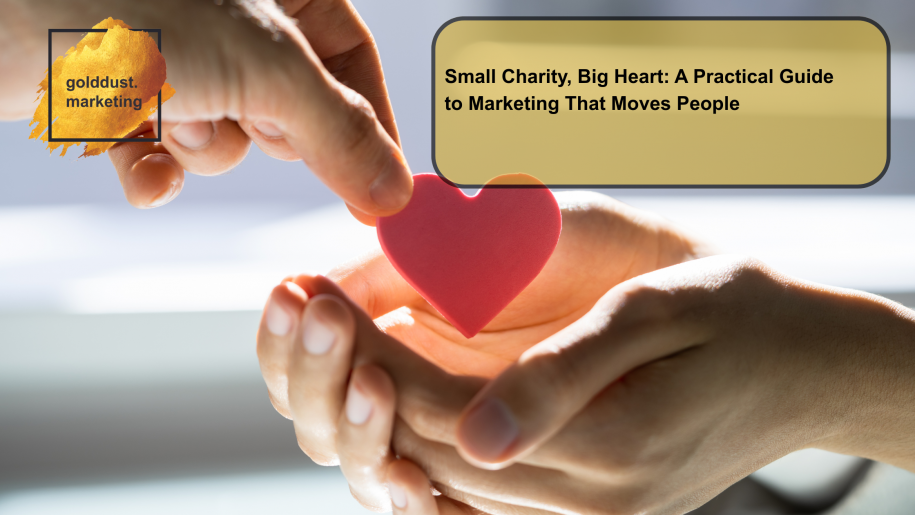Small Charity, Big Heart: A Practical Guide to Marketing That Moves People
Running a small charity often feels like juggling with one hand tied behind your back. You’ve got a mission that could change the world, but your team of three is already stretched thin, and your marketing budget wouldn’t cover a decent coffee run. Sound familiar?
Here’s the truth: you don’t need a Park Lane budget to create marketing that moves people. What you need is focus, authenticity, and a plan that actually fits your reality. Let’s build something that works for you, not against you.
Start with Purpose, Not Platforms
Before you even think about which social media platform to join, ask yourself one simple question: how does this serve our mission?
If it doesn’t serve the mission, it’s noise.
Your marketing should flow naturally from your purpose. For example, if your mission is to “support more families in crisis,” your marketing objective might be to “increase referrals from local services,” measured by a concrete goal like “25% more enquiries this quarter.” This isn’t about vanity metrics or follower counts – it’s about real impact you can track and report to your board of Trustees.
A One-Page Plan Beats a 20-Page Strategy
Time-poor teams need simple plans that actually get used. Create a charity marketing canvas that fits on a single page and covers:
- Your key audiences (donors, beneficiaries, volunteers, partners)
- What value you offer each group
- Your top 3 priorities for the next 90 days
- How you’ll measure success
- Your immediate actions
Trustees can grasp it in minutes, and your team can refer to it daily. Sometimes the best strategy is the one everyone actually remembers.
Make Every Pound Prove Its Worth
Your funders want to see impact, and so should you. Set up simple tracking using Urchin Tracking Model (UTM) codes on your links and basic goals in Google Analytics. Track your cost-per-result, whether that’s cost-per-donation, cost-per-volunteer signup, or cost-per-referral.
Don’t forget to log in-kind support too – those pro bono design hours and free Google Ad Grant credits add up and tell a fuller story of your marketing ROI.
Choose Fewer Channels and Do Them Brilliantly
Here’s your new mantra: Home base plus one social.
Your website is your hub—make sure those donate and referral buttons are crystal clear. Add email nurturing with a simple welcome sequence and monthly updates. Then pick one social platform you can sustain consistently.
This focus prevents burnout and creates real momentum where it matters most. You’d rather be brilliant on one platform than mediocre on five.
Put Dignity Before Clicks
Your beneficiaries aren’t content – they’re human beings deserving of respect and agency. Always secure informed consent before sharing stories, avoid “trauma-porn” that exploits vulnerability, and use strengths-based language that shows people as resourceful, not just needy.
This isn’t just about being ethical (though that’s reason enough). It’s about building trust with your community and protecting your reputation for the long term.
Content That Works for Small Teams
Repurpose relentlessly. That one powerful case study can become a blog post, an email story, a 60-second video, and a press release. Create content templates your team can use again and again and establish a simple approval process that doesn’t create bottlenecks.
A basic content calendar prevents last-minute panic and ensures you’re always sharing stories that matter.
Turn Partners into Amplifiers
Give your corporate partners, local schools, and community groups everything they need to champion your cause. Create ready-to-use toolkits with social media captions, poster templates, and presentation slides.
When you make it easy for others to support you, they become powerful multipliers of your message.
Follow-Up Is Where the Magic Happens
That successful fundraising event or appeal is just the beginning. Your stewardship sequence – the thank you, impact update, and next invitation – is what converts one-time supporters into lifelong champions.
Most charities celebrate the initial donation and forget the relationship. Don’t be most charities.
Be Ready Before You Need to Be
Create a simple crisis communications checklist now, while things are calm. Identify your spokespersons, establish escalation paths, and avoid depending on just one communication channel.
When tough moments come (and they will), you’ll respond with clarity instead of panic, protecting the trust you’ve worked so hard to build.
Your 90-Day Starter Plan
Ready to begin? Here’s what to tackle first:
- Week 1-2: Write your one-page marketing plan
- Week 3-4: Fix your donate/referral buttons and add alt text to images
- Week 5-6: Set up UTM tracking and create a simple dashboard
- Week 7-8: Commit to your “website + email + one social” focus
- Week 9-12: Build a partner toolkit and create a consented story bank
Small Steps, Big Difference
Marketing for small charities isn’t about having all the answers – it’s about taking consistent action with the resources you have. Test ideas, learn from what works, and repeat what brings results.
Your heart is already in the right place. Now you have a plan that meets you where you are and helps you reach the people who need to hear from you most.
Remember: every supporter started as someone who simply cared. Your job is to make it easy for caring people to find you, understand your impact, and take meaningful action alongside you.
Need help turning this into action? We’re here to support charities just like yours.

